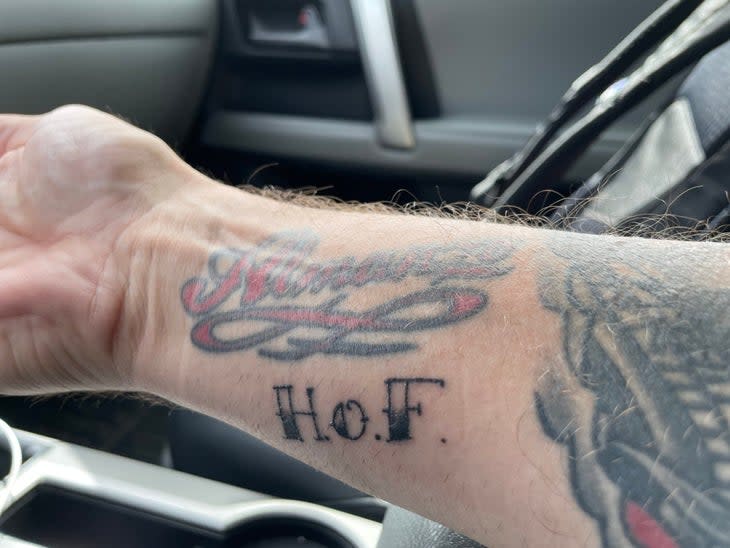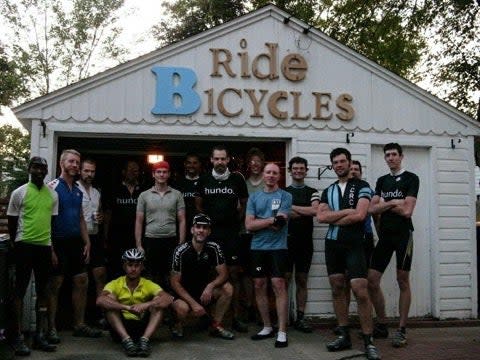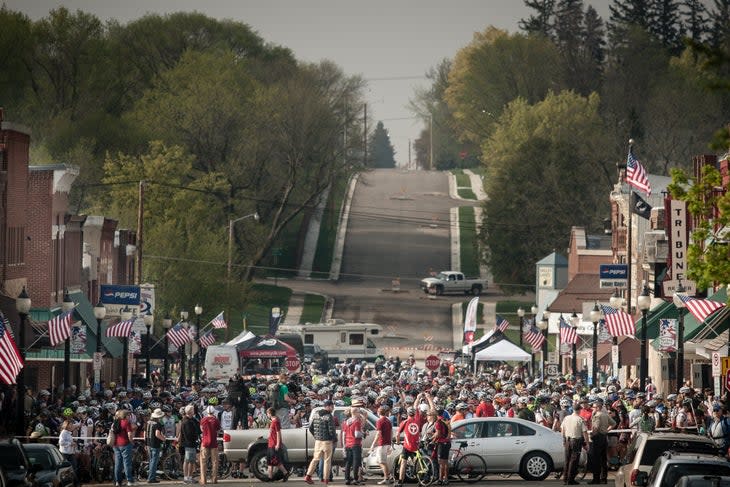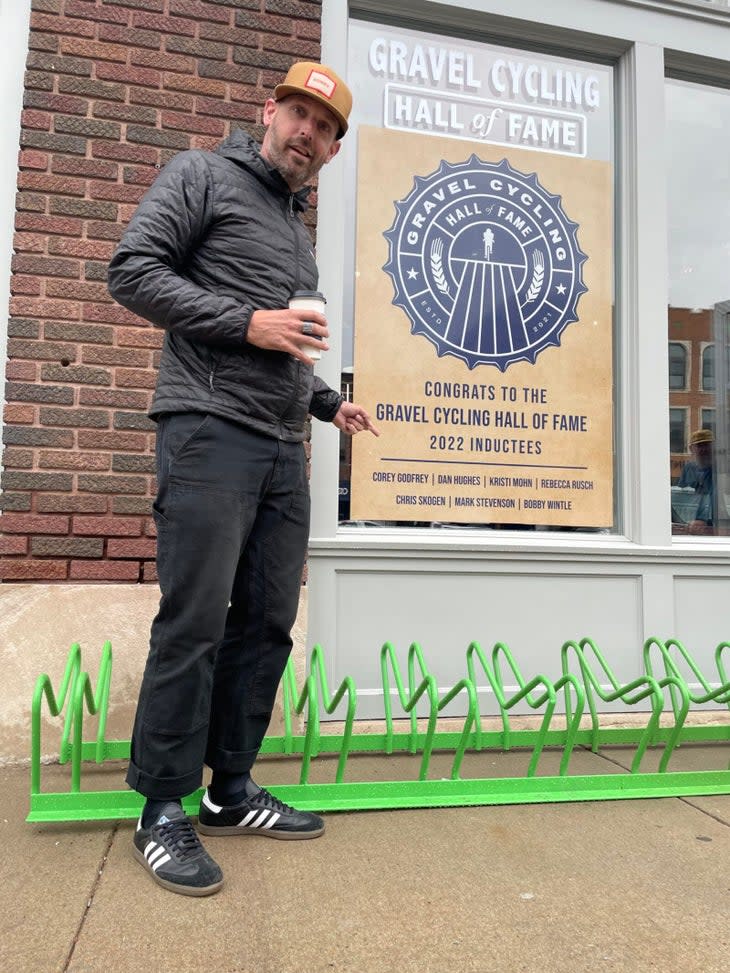From the ashes of gravel, Chris Skogen has been reborn
This article originally appeared on Velo News
On his right wrist, Chris Skogen has a tattoo.
In cursive script, the word Almanzo splays out about four inches long, the letters in bold red ink outlined with black. It looks like it could be a baseball team, or the name of his pet.
In fact, Almanzo is the name of a gravel race that Skogen launched in 2007 and ran, with wild success, for eight years. During that time, the event in southeastern Minnesota followed a trajectory now ubiquitous to the gravel race origin story: the Almanzo 100 grew from 12 participants in 2007 to over 1,400 when Skogen stepped away in 2014.
Many times during the past eight years Skogen debated having the permanent reminder of his bike race tattoo’ed over. He shuttered his event -- which had always been free to attend -- because he couldn’t deal with gravel’s rapid transformation from dirt roads to dollar signs. He disappeared off social media and tried to ignore any news about new events, products, or successes.
He saw the tattoo not as commemoration of his legacy in the discipline, but as a reminder of all that had gone wrong.
When Skogen was nominated into the inaugural class of the Gravel Cycling Hall of Fame and invited to Emporia, Kansas for the ceremony before Unbound Gravel, he had two acceptance speeches planned. One was an ironic middle finger to the whole thing. Another was something more gracious, written with his kids in mind.
Either way, he didn’t have much faith in the Hall of Fame for changing his mind about what had happened to gravel.
Yet after hearing the other inductees -- people like Corey Godfrey of Gravel Worlds, Kristi Mohn of Unbound, and Bobby Wintle of The Mid South -- credit each other for their own events’ successes Skogen was blinded by a light -- and it wasn’t the glare of big bike industry money.
“What I realized is that everyone had been listening,” he said. “Everyone had heard my message. For me that really undid eight years of trying to run away from this thing that I thought wasn’t recognized or no one acknowledged.
“I think that night held a mirror up in front of me and said ‘shut the fuck up, you're not that important. You might have done some stuff and had a grand vision for free everything, but the reality its, you did this thing and people saw it and realized it could be a thing and took it and did their own thing which might have been the most beautiful thing anyone could ever do.'”
After the ceremony, Skogen walked across the street to Maud’s Tattoo Company. He didn’t ask for Almanzo to be covered up. Instead, he added something below it, an acronym that, like the Hall of Fame itself, would further ink him into gravel’s slim volume of history: H.o.F.

The evolution of the Almanzo 100
Skogen says that he started the Almanzo 100 because he “was motivated by social justice and social reform.” A lifelong rider, Skogen was part of a rootsy ‘cross scene in Rochester, Minnesota in the early 2000s. At the same time, he taking classes at a community college, and a sociology professor said something that stuck with him.
“He was like, ‘you have the capacity to change the world if you harness it and are calculated about how to participate -- you can move mountains,'” Skogen said.
Skogen took the advice to heart and ran for mayor of his small town of Rochester in 2007. The young twentysomething went door-to-door introducing himself and his ill-formed platform. It cost him $50 to enter the mayoral race. The lessons he learned were priceless.
“What I realized is that politics are absolutely ridiculous,” he said. “If you really wanna see change, the way to do that is to build community. Politics is not community building.”
After deeming his mayoral campaign a bust, Skogen decided to address a different aspect of social justice, one directly related to his hobby of bikes. When one of his favorite ‘cross races moved to a town 100 miles away, he and some buddies had the idea to ride to the start of the event. The Almanzo 100 was born from the adventure.
"I thought that if we're going to ride there, we might as well invite other people to ride together, and it should be free,” Skogen said. “Racing bikes is terribly expensive anyway."
He hung his hat on the ‘free’ concept -- “I was really passionate about not having an entry fee and not selling it out,” he said. For eight years, as the event grew from 12 participants to 60, from 90 to 400, until it finally ballooned to over 1,000, Skogen never charged people to ride. He even added 162 and 380-mile distances.

“It was very organic, done on shoestring budgets,” he said. “I had a ton of help in the way of family and friends, none of it would have happened without those people.”
In neighboring midwestern states like Kansas and Nebraska and Iowa, other events were also growing faster than their creators could have ever imagined. Skogen said that everyone was in the same boat back then -- “not one of us had an idea of what we were doing.”
Being so intimately involved in the origins of the gravel scene gave Skogen an intense sense of ownership over its growth. He still wasn’t charging entry fees and didn’t plan to. Other events, born around the same time as the Almanzo 100, were starting to, and for new races reg fees were the norm.
It didn’t sit well with Skogen.
“It wasn't my purpose to have a bike race to make money, so I really became disenchanted with the whole gravel scene because I saw people making money on it,” he said. “For me it was like, ‘who the fuck are these people and how did they get here?'”
As pay to play gravel races bloomed across the country, the bike industry’s ears were ringing. In 2012, Salsa released the Warbird, the first gravel race-specific bike to hit the market. The year after, Challenge debuted a tire named after the Almanzo 100. The juxtaposition of running a free bike race with an industry capitalizing on the popularity of said bike race hit way too close to home for Skogen. He couldn’t help but take it personally.
“I’m looking in the mirror in 2012 after the Warbird came out and money is coming my way,” he said. “Wherever I went I was the greatest thing ever. At the end of the year, I looked at myself and said, ‘who are you? You didn't do anything. You don't deserve this stuff. The people who are coming to this event are the ones who deserve it.'”
Whistling in the dark
Rather than ride the wave and reap the good fortunes of the newly branded gravel industry, after the 2014 Almanzo 100 Skogen paddled back to shore.
He quit riding gravel, exclusively mountain biking, “only in the woods with a select group of people.” He worked in bike retail, but whenever the Almanzo 100 came up in conversation, “I worked hard to downplay it,” he said.
“Imagine the headspace of having a bunch of regret for doing something and having that be the thing that people want to hang onto about you. It's a perplexing headspace to live in. Imagine you invented the car and then could only attach the automobile to the fact that it's destroying the planet.”
Skogen lived in that headspace for nearly eight years. He thought that disappearing from the scene was doing everyone a service, and in the way of the mind he believed his own story. He tried to find purpose in other ways, but “I chased it down avenues I probably shouldn't have,” he said.
“I chased it in relationships, creativity, work, food, not exercising. I got divorced. I moved to New York City. I left my kids, I moved back to my kids. I took weeks-long road trips. I changed my social media, sometimes I would have it and sometimes I wouldn't.”

Meanwhile, gravel was having its heyday.
The event formerly known as Dirty Kanza wasn’t just a bike race anymore, there were spring training camps and official women’s initiatives. Gravel Worlds in Nebraska was charging entry fees despite launching with a model similar to Skogen’s.
Skogen said that he largely tried to ignore the news but that occasionally he’d get a glimpse through media or conversation. Sometimes, jealousy surfaced. He tried to counter it with a version of whistling in the dark -- convincing himself that his dark place wasn’t nearly as bad as giving in to Big Gravel.
“I'd see people have what I examined to be some layer of success, and I was like, ‘well that could have been me, but I'm not a sell-out, I didn’t sell out,'” he said. “And I really hung my hat on that idea. To fall back on this idea that I wasn't a sell-out was all me whistling in the dark. Trying to drown out my fears. To get to a place where I didn't have to see it or hear it.”
Now, Skogen realizes that his thoughts and the story he was telling himself influenced his worldview of gravel far more than what was actually happening in real time. He was consumed by what he perceived to be gravel’s rabid consumption of the things he deemed important -- namely access -- to the point that he wanted his name and race out of the history book entirely.
What he didn’t realize was that it was far too late.
‘Yes is the answer, what is the question?’
At the Gravel Cycling Hall of Fame induction banquet in Emporia on June 1, Bobby Wintle of The Mid South shared an anecdote with the crowd. He recalled his first encounter with Skogen at Frostbike, a bike industry retailer event, in early 2013. Wintle was about to launch the then-Land Run 100 and he asked Skogen for advice.
Skogen told Wintle about an experience he’d had as a bartender in Rochester, when a successful businessman came into the bar and ordered two things that Skogen didn’t have. Rather than chastise the young bartender, the man was gentle with him, suggesting that instead of saying no, he should offer the customer a solution:
“If it's me, and you come into my bar and you ask for Grey Goose and I don't have it, I'm gonna tell you, ‘I'm sorry sir I don't have that today, but if I had it here at 5 tomorrow would you come back?'”
On another visit, Skogen asked the man for general life advice. His suggestion on how to approach tough situations was along the same lines as before: “He said, ‘yes is the answer, what is the question?’
“That shaped me so far into the future, I wouldn't have even known it,” Skogen said.
And so it was the advice that Skogen passed on to Wintle on the eve of the first Land Run 100, and it’s a line that Wintle uses ad nauseam now.
When Skogen heard Wintle -- whose charismatic personality and genre-bending race occupy their own place in gravel’s history -- share that anecdote with the audience, “it blew my mind,” he said.
“That's the crazy part for me because Bobby is the face of this. Bobby just validated everything I've ever done.”

As unlikely as it seems, Skogen said that eight years of feeling purposeless, bitter, and angry receded rapidly into the rearview that evening. Sitting at a table with Kristi Mohn, another inductee to the Hall of Fame, Skogen was reminded of his relevance to the room.
“Kristi said, ‘I can't believe I'm sitting at a table with you,’ and I’m like, ‘what? It's me to you!'”
Listening to the acceptance speeches, it started to occur to Skogen that despite the changes in gravel and the different approaches to putting on events and working within the bike industry, everyone seemed to feel the same way about the fundamentals. Everyone had seen the transformative power of giving people a place to ride their bikes within a supportive and festive atmosphere. Sure, some charged money and a lot of it. Some took a lot of money from the industry. But, no one was doing it in a vacuum.
“Everyone took it and did their own thing with it and that's the best thing that could have happened,” Skogen said.
Skogen left Emporia after getting his H.o.F tattoo and before the masses arrived for Unbound. His drive back to Minnesota from Kansas gave him plenty of time to reflect on the unexpected revelations from the event. He found himself thinking about what makes gravel racing special, a topic he’d imposed a heavy boycott on eight years before.
Is Skogen ready to re-launch the Almanzo 100 or start something new? He can’t yet say because he’s not sure himself. But he does know that the journey of a gravel racer is much like the one he’s currently embarking on. That an experience can be amazing and then horrible and then amazing all over again.
“None of this gravel stuff is even really about racing,” he said. “But it's all about finishing. So if you take the winners of any gravel event, Unbound or otherwise, the winners will almost always tell you, ‘that was really hard, I'm so glad I’m done, I can’t wait to come back.’ The most accomplished athletes will tell you that.
“If you go to the last finisher, what are they gonna tell you? ‘That was really hard, I’m really glad I'm done, I may or may not come back again.’ The same story from both ends. And the story in the middle is the same, too.
“My journey to get to Kansas was the same. What I went through is really hard, and I'm glad it's done, and I look forward to whatever comes next. It really is the strangest outcome I never expected. When you don't expect a thing to happen is when it happens.”
For exclusive access to all of our fitness, gear, adventure, and travel stories, plus discounts on trips, events, and gear, sign up for Outside+ today.

